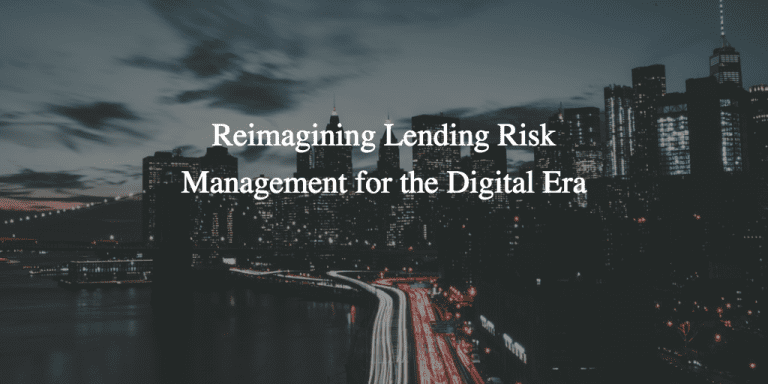
[Editor’s Note: This is a guest post from Venkatesh Bala, PhD, the Chief Risk Officer for Biz2Credit, LLC, a leading online marketplace for small business credit based in New York. Biz2Credit has facilitated more than $1.7B in funding since 2007.]
As of February 2018, US bank lending of various kinds – auto loans, commercial credit, mortgages, credit cards or small business lending – constituted $11.7 Trillion, representing around 60% of US GDP and 70% of commercial banking assets. Maintaining the health and profitability of these assets over the business cycle is critical for the banking and financial sector and for the overall US economy.
Banks are grappling with how best to use digital technology in their organizations. Advances in digital technology, data science and machine learning/AI present new opportunities to manage lending risks and maintain a strong balance sheet that is resilient to changes in the credit cycle.
To achieve these objectives, it is possible to envision a new digitally-enabled playbook for risk management. Managing the risk with bank and other lending, instead of being a highly specialized silo, can instead become an enterprise-wide responsibility and capability.
The reason is that all business functions – from underwriting, servicing and collections to sales, marketing and treasury, impact the portfolio risk. Marketing, for instance, directly affects the riskiness of customers coming through the door, while sales interactions determine whether relationships are built with more or less risky customers. Equipping these functions with relevant risk information through digital means can empower them to reduce the totality of risk from lending.
Near-Term
Near-in, the biggest benefit lies in loan underwriting and monitoring. Digital data is now available from an ever-expanding set of sources, including bank statements, social media, credit bureaus, mobile phones and call centers. The key insight is that this data can be combined with lending outcomes and used for risk reduction.
Small business lending offers an illustrative example. Picture three satellite images of gas stations in different parts of the US, with various landmarks present in the images. The first is near a school and a church, the second is close to suburban housing and the third lies between a church and a large apartment complex. Which of these gas stations has the highest revenue, and which the lowest? Which of them is most at risk of default on a small business loan?
As part of a customer loan application and repayment, the bank would collect information on revenue and default status. We might hypothesize that gas stations near retail traffic generators such as schools, apartments and places of worship are more likely to have good revenue and cash flow, with a lower chance of default. (In actual fact, the second gas station above had the lowest revenue and also defaulted, supporting the hypothesis!)
Machine learning can take such information from thousands of satellite images, correlate them with business revenue and loan repayment outcomes and conduct pattern recognition.
Underwriters can see these findings on their computer screens, which can also be continuously updated with new information.
Note that machine learning can only identify interesting patterns – the underwriter will still need business judgement to use the findings. However, she will be able to make more informed judgements about risk factors by knowing exactly where to look. There will also be greater consistency of loan decisioning across the underwriting team.
Continuous monitoring is the other essential element of the digitally-enabled playbook in the near-term. The need arises because the borrower always knows more about their current repayment situation than the lender, creating the risk that the latter can be blindsided.
By monitoring the borrower regularly and using predictive analytics and preset alerts, the Servicing and Collections functions can respond rapidly to changes in borrower circumstances and repayment behavior, essential to managing risk. (The best practice would be for the customer to be fully informed and provide consent, in exchange, say, for better terms).
Roadmap
Longer term, the capability for lending risk management can be extended to all functional areas, including marketing, sales, finance and even legal and compliance.
Historically, marketing segmentations have been developed independently of risk. Digital data on risk outcomes can be incorporated to create true risk-based segmentations, while intake by segment can be displayed in real-time on a marketing dashboard. Marketing instantly visualizes the impact of segmentation efforts and can adjust marketing communications and other strategies accordingly. Encouragingly, global lenders are starting to take initial steps in this direction.
Sales incentives are largely not aligned with risk. Sales seeks to grow the customer base and constantly receives pushback from risk management to preserve loan quality. A scorecard capturing prospect risk factors can be made available to Sales Relationship Managers. They can use it to prioritize customer prospects, and also use it to generate value: for instance, cross-selling an overdraft protection product on the basis of a specific risk factor on the scorecard.
At present, much of the focus of digital investments within lending occurs at the customer-facing front end. While this is much needed, equal importance should be given to how digital resources can reduce lending risk at the back-end. Such efforts should be systematic and part of a well-conceived strategy.
The potential impact of the new way to think about risk should not be underestimated. The outcome will be nothing less than a transformation of the bank balance sheet, including lower capital buffers and improved Tier 1 Capital to meet Basel III-type regulatory requirements. Individual banks and the financial sector will undoubtedly be stronger by adopting this digital playbook. Bankers and regulators will also be able to sleep better at night.


